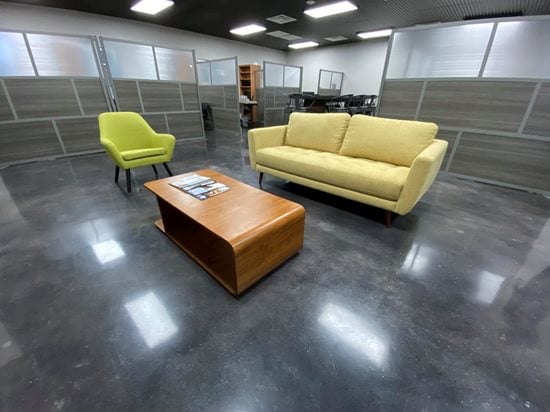
SUNDEK Products USA in Grand Prairie, TX.
Polished concrete has been popular for years for both residential and commercial floors because of its beautiful sheen, ease of maintenance, and durability. But many flooring contractors are discovering that they can save time and effort, while achieving a similar level of shine and beauty, by burnishing the concrete rather than polishing. Although burnishing isn’t a substitute for polishing on every project, it’s a great alternative for jobs that don’t require a super-high-gloss finish or the need to grind down and correct the surface.
Find concrete floor contractors near me.
What is a burnished concrete finish?
Burnishing machines are similar to floor buffers but spin at a much higher speed, typically around 1,500 to 2,500 rpm. Equipped with diamond-impregnated buffing pads, burnishers use their powerful rotation action to heat, melt, and buff a chemical coating into the surface (typically a waxed-based product) that fills the pores of the concrete and gives the floor a glossy, satin-like sheen.
Like polishing, burnishing can only be done on fully cured, hardened concrete. The resulting finish is very different from the burnishing of newly placed concrete, which involves troweling the fresh concrete over and over again to achieve natural highlights and lowlights. To learn more, read How to Make a Concrete Floor Look Like Marble.
How does burnishing differ from concrete polishing?
Although the terms polishing and burnishing are sometimes used interchangeably, polishing is a multistep process requiring the use of heavy machines equipped with diamond-segmented abrasives to grind down the concrete slab and achieve the desired degree of gloss and smoothness. Concrete polishing also involves applying a chemical hardener to the surface before grinding to densify the concrete and improve its durability.
Burnishers aren’t powerful enough or heavy enough to grind down and abrade concrete, so they will not correct any bumps or dips or remove minor surface flaws. As with polished concrete, a densifier can be used when burnishing concrete to give the surface a greater degree of durability and toughness, but it won’t achieve the same level of surface hardness.
What are the pros and cons of burnished concrete floors?
The primary advantage of burnished concrete, for both contractors and their clients, is the cost savings when compared to polished concrete. When you factor in the expense of a heavy-duty concrete grinder and all of the accessory items needed to polish a concrete floor, you’re looking at a major investment (see Concrete Polishers and Equipment). Plus there are many safety precautions that must be taken during the grinding process, especially concerning the generation of silica dust, which can be dangerous if inhaled.
Burnishing won’t achieve the same degree of light reflectivity possible with polished concrete. It also won’t give you the same ability to “customize” the finish and choose different levels of sheen and aggregate exposure (see Levels of Concrete Polishing — Comparing Different Finishes). However, burnishing will still create a floor surface that’s extremely durable and easy to maintain, and dust generation is minimal.